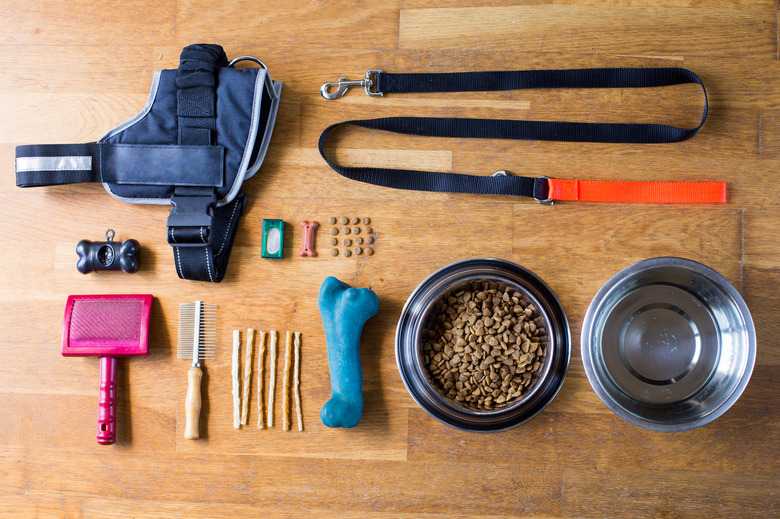Preparing For Emergencies And Evacuating With Pets — An Emergency Plan Guide
We may receive a commission on purchases made from links.
When disaster strikes, it pays to be prepared for evacuating — and that includes being prepared for evacuating with pets. Pets require special consideration during emergencies since many emergency shelters (including most facilities operated by the Red Cross) do not accept furry, feathered or scaly friends unless they are service animals. To make matters worse, scared pets often end up escaping when they encounter a natural disaster, be it a flood, fire, hurricane, earthquake or any other emergency. That's why both your disaster preparedness plan and your emergency kit need to take into account your critter's needs so you can keep your pet safe when evacuating.
Create an Emergency Plan
Create an
Emergency Plan
First, consider what types of emergencies are most likely to occur in your area. Do some research on the best way to address this type of emergency in your specific location, including the best evacuation routes for different scenarios. While shelter locations tend to vary based on the nature of an emergency, it can help to look up where they were located during past emergencies and find out if any locations near you offered accommodations for pets.
Write a detailed evacuation plan that includes plans for a safe place for you and your pet to stay. Since most evacuation centers do not accept pets and your local animal shelter may be overrun by strays and runaway pets during an emergency, you may need to find a pet-friendly hotel or out-of-town friends and family members who will provide you and your pet with a place to stay, or you may look for local boarding facilities or animal hospitals that may care for your pet while you stay in an evacuation center. Remember to find different options in different parts of town or even outside of your immediate area so you can have somewhere to stay no matter what area is affected by the emergency.
Account for the possibility that you may not be at home when the disaster strikes. Create a buddy system with a neighbor or a friend who lives nearby. Exchange house keys and agree that if an emergency happens while one of you is away, the other person will take over the evacuation process for all of your pets. Never leave a pet chained up while you are away or they could be trapped if an emergency occurs and no one is able to free them.
Put Together an Evacuation Kit
Put Together an Evacuation Kit
Every household should have an emergency supply kit with important supplies for the entire family, such as food, a change of clothes, important documents and a first-aid kit. For pet owners, this also means preparing supplies for your critter.
Include your pet's medical records, microchip information, license documents, ownership paperwork and a recent photo with you and your pet to establish ownership in a hurry. Add your veterinarian's phone number, the number for the local branch of American Society for the Prevention of Cruelty to Animals and the number for the local Humane Society to the emergency contacts list included in your kit and program these numbers into your cellphone as well. If your emergency shelter plans for your pet fail, you may want to call the ASPCA or Humane Society since these agencies often have crisis shelters in place to help pet owners and first responders who come across animals in danger. You may also want to print missing pet fliers that are kept current with a recent pet photo and store them in your kit just in case your pet gets lost during an emergency — and keep the papers in a waterproof container.
Pack a two-week supply of food for each animal, a food bowl, a water bowl, a can opener (if your pet eats canned food) and at least two weeks of any medications or medical devices your critter uses. You'll probably want a pet carrier labeled with your pet's name, your phone number and your name on the outside. Have a harness and a sturdy leash for each animal that can use one. If your pet has a favorite type of toy or blanket that makes her feel safe or happy, place these in your kit as well. Don't forget to pack products to deal with your pet's waste. This means litter and a disposable aluminum pan (to serve as a litter box) for cats and poop bags for dogs.
Keep Your Pet Prepared
Keep Your Pet Prepared
Ensure your pet is up to date on his vaccinations and keep an updated copy of his vaccination record in your emergency kit. For animals that can wear collars, keep these on your pet at all times along with a personalized ID tag that has your up-to-date contact information. If you have a dog, keep his license up to date so the county has your most current contact information. Whatever kind of pet you have, get him microchipped and keep the microchip company updated with your most current address, email and phone numbers.
Get your pet used to riding in the car you would use in an emergency and help train them so they are comfortable in his pet carrier. Do practice drills with your family and pet periodically so everyone feels comfortable with your evacuation plan. Learn your pet's favorite hiding spaces so you can find them, extract them safely and get them in the carrier if they are scared during an emergency.
Evacuating in an Emergency
Evacuating in an Emergency
When an emergency happens, remember to be prepared for the unexpected but never leave your pet to fend for themselves or they could be harmed or killed in the disaster. Remember that if your home isn't safe for you, it's not safe for your pet either. If possible, evacuate early to reduce the stress on yourself, your family members and your pet. Try to stay calm and follow your emergency plan as much as possible but always follow the advice and instructions given by emergency first responders, as they are trying to keep everyone safe.
Try to keep your pet away from unfamiliar animals during an emergency. Not only can scared creatures attack, but other animals can be carrying diseases, such as rabies or kennel cough. Always watch your pet and ensure she does not play in or drink from dirty water that could cause them to become sick. Keep your pet on a leash or in a carrier so they do not escape. Be sure to wash your hands after handling your pet or her waste, as they could be exposed to dangerous bacteria or disease as a result of the emergency situation.
To keep yourself safe, practice caution while handling your animal, as they may be scared. If your pet is injured, remember that while proper first aid could save their life, they may bite or scratch from fear or pain, so be cautious and keep your face away from their face and claws. If they are stressed or move in a way that could exasperate the injury, discontinue treatment. Take an injured pet to a local veterinarian as soon as possible. If you are bitten or scratched, be sure to seek medical treatment.
Before entering your home after evacuating, check your house to ensure it is safe for you and your pet. Be patient with your pet if they are scared, cautious or just acting a little abnormal once you return. If you suspect they may be ill, contact a veterinarian.
If Your Pet Is Lost
If Your Pet Is Lost
First, take care of yourself and your family and only search for your pet when and where it is safe to do so. Put up missing pet fliers and bring one to your local animal shelter. Look for animal rescues, vet clinics and other groups that may take in lost pets during the emergency and call to see if they may have your pet. Call your pet's microchip company to let it know your animal has gone missing and verify that it has your contact information up to date.
Sheltering in Place
Sheltering in Place
Sometimes, an emergency requires you to stay at home rather than evacuating. To keep your pet safe inside while things are scary outside, create a safe room with the necessary pet supplies. Remember to remove any toxic chemicals or plants that your pet may get into. You may want to place the pet's carrier in the space along with a comfortable blanket so he has a place to hide if he gets scared but try to close off any spaces in the room where he may hide and get stuck, like an air vent or a difficult-to-reach space under furniture.
References
- Centers for Disease Control and Prevention: Pet Safety in Emergencies
- American Red Cross: Pet Disaster Preparedness
- Ready.gov: Prepare Your Pets for Disasters
- The Humane Society of the United States: Make a Disaster Plan for Your Pets
- American Kennel Club: Emergency Preparedness: The Essential Guide for Dog Owners


